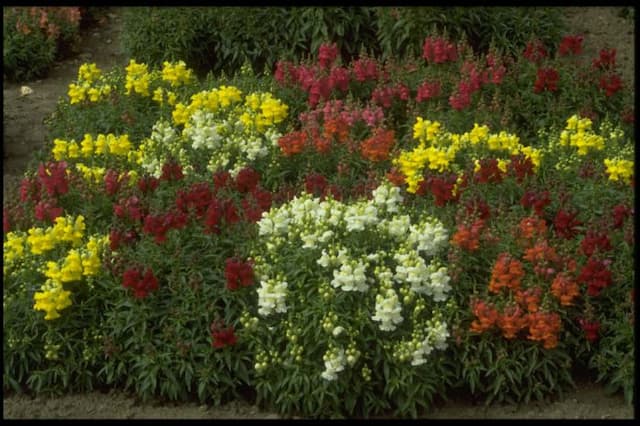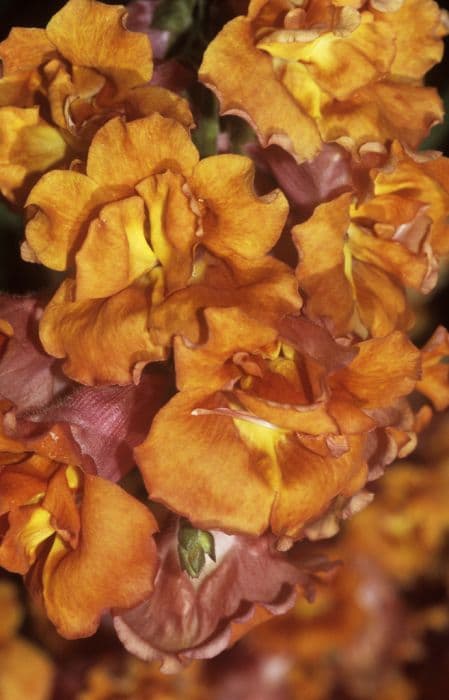Beardtongue Penstemon Phoenix Appleblossom = 'Pheni Ablos' (Phoenix Series)
![penstemon [Phoenix Appleblossom]](/_next/image?url=https%3A%2F%2Fplants-admin.emdemapps.com%2Fimages%2Fplants%2F%2Fimages%2F604b553795aab.png&w=3840&q=75)
ABOUT
Penstemon Phoenix Appleblossom, as its name suggests, features a delightful array of blooms reminiscent of apple blossoms. The flowers are a soft shade of pink with a hint of white, which gives them a gentle and welcoming appearance. They exhibit a tubular structure, typical of penstemons, attracting a variety of pollinators with their beckoning shape. The blooms are arranged in clusters along the stems, creating a luxurious and abundant floral display that is both eye-catching and elegant. The foliage underneath these beautiful flowers is lush and green, forming a dense mound that serves as a perfect backdrop for the pastel blossoms. The leaves of this variety are lance-shaped, providing an attractive, textured look even when the plant is not in bloom. The plant typically has a bushy, upright habit, showcasing the blooms prominently for garden admirers to enjoy. Overall, the Penstemon Phoenix Appleblossom is known for its charming flowers and its ability to add a soft, romantic touch to any garden setting.
About this plant
 Names
NamesFamily
Plantaginaceae
Synonyms
Beard Tongue, Penstemon
Common names
Penstemon 'Pheni Ablos'
 Toxicity
ToxicityTo humans
Penstemons, including the Penstemon Phoenix Appleblossom, are generally considered non-toxic to humans. There should be no significant risk of poisoning or adverse health effects from ingesting parts of this plant. However, it is always advisable to avoid eating ornamental plants and seek guidance from medical professionals if ingestion occurs and there are concerns about health effects.
To pets
Penstemons, including the Penstemon Phoenix Appleblossom, are generally considered non-toxic to pets. They are not known to cause any significant symptoms of poisoning or to have harmful consequences if pets ingest parts of the plant. However, as with any non-food plant, it is best to prevent pets from eating large quantities of plant matter to avoid gastrointestinal upset.
 Characteristics
CharacteristicsLife cycle
Perennials
Foliage type
Deciduous
Color of leaves
Green
Flower color
Pink
Height
2 feet (0.61 meters)
Spread
2 feet (0.61 meters)
Plant type
Herb
Hardiness zones
8
Native area
North America
Benefits
 General Benefits
General Benefits- Attracts Pollinators: The Penstemon Phoenix Appleblossom is known to attract bees, butterflies, and other beneficial insects, contributing to the health of the ecosystem.
- Low Maintenance: Once established, it requires minimal care, making it suitable for gardeners with limited time.
- Drought Tolerant: This plant is capable of surviving periods of low water availability, making it ideal for arid climates or water-conservative gardens.
- Colorful Blooms: It produces vibrant appleblossom-pink flowers that can add aesthetic appeal to any garden.
- Long Blooming Period: The flowering season extends from late spring to early fall, providing long-lasting color in the landscape.
- Versatile Planting: Suitable for borders, container gardening, and as part of a mixed flower bed.
- Adaptable: It can thrive in a variety of soil types, though it prefers well-draining ground.
- Hardy: Penstemon Phoenix Appleblossom has good resistance to pests and diseases, reducing the need for chemical treatments.
- Herbaceous Perennial: As a perennial, it will return year after year, offering lasting value to the garden.
- Cold Tolerant: It can survive in cooler temperatures, making it suitable for many different climate zones.
- Habitat Enrichment: It contributes to the local habitat by providing food sources for pollinators.
 Medical Properties
Medical PropertiesThis plant is not used for medical purposes.
 Air-purifying Qualities
Air-purifying QualitiesThis plant is not specifically known for air purifying qualities.
 Other Uses
Other Uses- Photographic Subjects: Penstemon flowers, with their vibrant colors and interesting shapes, are often used by photographers looking to create natural, garden-themed compositions.
- Educational Tools: Penstemons can be used in botany classes to teach about plant biology, pollination, and hybridization techniques due to their diverse range of species and hybrids.
- Weather Indicator: Some gardeners observe the behavior of Penstemon flowers to predict the weather, as certain species may close up in anticipation of rain.
- Illumination: When strategically planted, their light-reflective petals can brighten up dim garden areas, even after the sun has set, by reflecting any available light.
- Dye Production: The petals of some Penstemon varieties can yield natural dyes for textiles or crafting when treated correctly.
- Culinary Decoration: Edible species of Penstemon can be used as decorative garnishes on food plates, bringing an unexpected floral touch to culinary presentations.
- Natural Confetti: When dried, the petals can be crumbled and used as bio-degradable confetti for outdoor celebrations, reducing environmental impact.
- Artistic Inspiration: Penstemons' form and texture inspire artists and can be used in art education to illustrate concepts like symmetry, pattern, and color in nature.
- Ice Cube Embellishment: Freeze petals in ice cubes for a floral touch in beverages, creating an elegant and subtle surprise for guests during events.
- Jewelry Making: Delicate Penstemon flowers can be dried and preserved in clear resin to create unique, nature-inspired jewelry pieces.
Interesting Facts
 Feng Shui
Feng ShuiThe Penstemon is not used in Feng Shui practice.
 Zodiac Sign Compitability
Zodiac Sign CompitabilityThe Penstemon is not used in astrology practice.
 Plant Symbolism
Plant Symbolism- Resilience: The Phoenix in its name denotes rebirth and the ability to withstand or recover from difficult conditions, mirroring the legendary bird's rising from ashes.
- Balance: The harmony of Penstemon's two-tone flowers symbolizes equilibrium and the beauty found in combining diverse elements.
- Boldness: Its bright, showy blooms embody confidence and the willingness to be in the spotlight.
- Gratitude: Often given to show appreciation, Penstemon flowers can represent thankfulness for support or friendship.
- Health: Penstemon plants, in traditional herbalism, were sometimes associated with healing properties and thus can symbolize good health.
 Water
WaterFor the Beardtongue (Penstemon), it's essential to maintain a balance in watering, ensuring the soil is moist but not waterlogged. Typically, you should water your Beardtongue once a week with about one gallon of water per plant, depending on weather conditions. During hot and dry spells, more frequent watering may be necessary, while in cooler, wetter periods, you can reduce the frequency. Ensure you water at the base of the plant to avoid wetting the foliage, which can lead to fungal diseases. It's best to water in the morning to allow any excess moisture on the leaves to evaporate during the day.
 Light
LightThe Beardtongue thrives best in full sun conditions where it can receive at least six to eight hours of direct sunlight per day. An ideal spot would be in a south-facing or west-facing garden that is not overshadowed by taller plants or structures. While it can tolerate some light shade, the abundance of blooms and overall plant health will be optimal when planted in a bright and sunny spot.
 Temperature
TemperatureBeardtongue plants are hardy and can withstand a range of temperatures but perform best in temperate conditions. They can tolerate minimum temperatures down to around 20 degrees Fahrenheit (-6 degrees Celsius) once established but prefer a climate where the temperature ranges between 50 and 85 degrees Fahrenheit (10 to 29 degrees Celsius). Avoid exposing the plant to prolonged periods of frost or intense heat above 90 degrees Fahrenheit.
 Pruning
PruningPrune Beardtongue to promote new growth and extend the blooming period. After the initial bloom in late spring or early summer, deadhead spent flowers to encourage a second bloom. In late winter or early spring, prune back the plant to about 4 inches from the ground to stimulate healthy new growth. The best time to prune is when new growth appears at the plant's base.
 Cleaning
CleaningAs needed
 Soil
SoilThe Beardtongue prefers well-draining soil with a mix of loam and sand. A good soil recipe would be a blend of two parts loam or potting soil to one part sand to improve drainage. This plant thrives in slightly acidic to neutral pH, ranging from 6.0 to 7.0. Regular mulching can help maintain soil moisture and temperature.
 Repotting
RepottingPenstemon, or Beardtongue, generally does not require frequent repotting and can be done every 2-3 years. It is best to repot when the plant outgrows its current container or when the soil quality depreciates.
 Humidity & Misting
Humidity & MistingBeardtongue prefers moderate to low humidity levels, as it is well-adapted to dry climates. Humidity levels around 40-50% are ideal for this plant, making it suitable for most indoor environments without the need for additional humidity control.
 Suitable locations
Suitable locationsIndoor
Place in bright, indirect light, well-draining soil.
Outdoor
Needs full sun, well-drained soil, mulch seasonally.
Hardiness zone
5-9 USDA
 Life cycle
Life cyclePenstemon Phoenix Appleblossom, commonly known as the Beardtongue, begins its life cycle as a seed, typically sown in early spring to late summer. Upon germination, it develops a basic root system and foliage, characterized by lance-shaped leaves. As the plant matures, it enters a vegetative state where it focuses on leaf and stem growth to build a sturdy framework for flowering. The next stage is flowering, which occurs in late spring to summer, where it produces tubular flowers that range from pink to white with a notable apple blossom hue. After pollination, which is often assisted by hummingbirds and bees, the plant sets seeds that mature, signaling the end of the reproductive cycle. If environmental conditions are favorable, the Penstemon Phoenix Appleblossom may enter a period of dormancy in winter, only to rejuvenate and begin the cycle anew in the following spring.
 Propogation
PropogationPropogation time
Spring to Summer
The most popular method of propagating Penstemon Phoenix Appleblossom, also known as 'Pheni Ablos', is through stem cuttings. This process usually occurs in the spring or early summer when the plant is actively growing. To propagate, one should select a healthy, non-flowering stem and make a cut just below a node, about 3 to 6 inches (approximately 7.5 to 15 centimeters) in length. The lower leaves are then removed, and the cut end is dipped in rooting hormone before being inserted into a moist potting mix. The cutting should be placed in a warm, brightly lit area but out of direct sunlight to encourage root growth. Roots typically develop within a few weeks, after which the new plant can be transplanted into the garden or a larger pot.


![Hebe [Garden Beauty Purple]](/_next/image?url=https%3A%2F%2Fplants-admin.emdemapps.com%2Fimages%2Fplants%2F%2Fimages%2F604b646a3d922.png&w=640&q=75)





